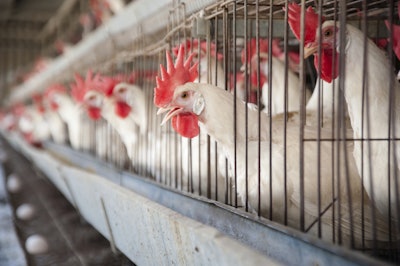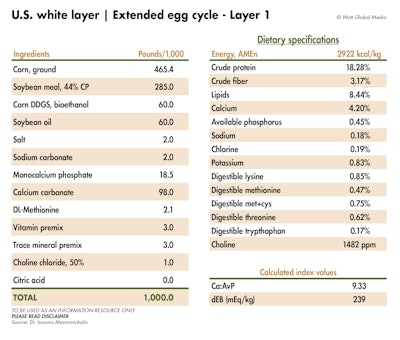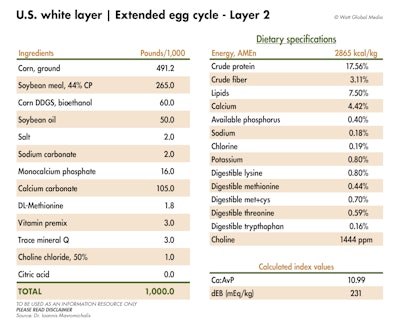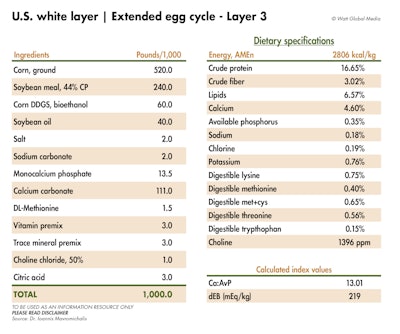Feed formulations for US white layers in the production phase
Collection of white layer feed formulas for one extended egg cycle in the production phase (Weeks 18 to 100)
Ioannis Mavromichalis, Ph.D.

These generic formulas have been designed having a target feed intake of 100 grams/bird for the entire egg cycle. Exact energy and protein (amino acids) requirements can vary depending on genetic line, body weight, egg size and numbers, temperature, and housing system.
All the above will determine actual dietary specifications for each farm. Thus, these formulas give a reference point on how layer formulas are structured.
Energy
The main energy source in the U.S. remains corn, with soybean oil — or any other inexpensive but good-quality lipid source — being used to bring dietary energy levels to relatively high numbers.
Energy levels drop as birds age because feed intake capacity increases faster than maintenance requirements as body weight reaches mature levels. A reduction of about 50 Kcal ME per kg feed is considered a good rule of thumb for each phase.

Downloadable PDF: US white layers in the production phase of an extended egg cycle - Layer 1
Protein
Soybean meal is used as the main protein source, whereas DDGS is an inexpensive protein supplement that is still being used in the U.S. The level of 6% DDGS used here is to denote its presence and not any inclusion level recommendations.
These formulas are formulated so that enough soybean meal covers the requirement for digestible lysine, whereas feed-grade DL-methionine is used to cover the remaining methionine and cysteine combined requirements. Once this is done, all other amino acids are at or above requirements levels.
Minerals and vitamins
Calcium is the main mineral that affects eggshell formation and quality. Layers require large amounts of calcium and this is reflected by the unusually high levels of dietary calcium (3.8 to 4.6%) in all layer formulas. Phosphorus is supplied just above its required levels to avoid interfering with the absorption of calcium.
Likewise, sodium bicarbonate is used to supply enough chlorine, whereas the remaining sodium requirements are met by sodium chloride (salt). With enough soybean meal in the diet, total potassium levels are enough (more than 0.7%) to bring the dietary electrolyte balance above 200 mEq/kg, which is considered minimum for eggshell quality and litter quality.
All trace minerals are to be supplied by a suitable premix which is separate from the vitamins to ensure vitamin stability. This is also why choline chloride (an aggressive vitamin) is supplied outside the usual premix.
Finally, some citric acid is included as it has been shown to improve calcium digestibility and absorption, although this is not always followed.

Downloadable PDF: US white layers in the production phase of an extended egg cycle - Layer 2
Feeding schedule
The pullets are fed a pre-layer diet (same as the Layer 1 formula, only with 2.2% instead of 4.2% calcium) until they reach about 2% egg numbers. Then, the Layer 1 formula is used until daily egg mass starts to decline. This is determined by the genetic line used.
Then Layer 2 feed is used until week 80 — again as determined by the genetic supplier — to be followed by Layer 3 until the end of the cycle (usually at 100+ weeks). Such an example program can be as follows:
Until 50 weeks = Layer 1
50-80 weeks = Layer 2
80+ weeks = Layer 3
It should be noted that, as hens age, their feed intake capacity increases, but their ability to digest, absorb and metabolize dietary calcium diminishes. Hence the increased calcium concentration in the final feed.

Downloadable PDF: US white layers in the production phase of an extended egg cycle - Layer 3
Alternative ingredients
Wheat and sorghum are used frequently, whereas some poultry byproduct meal and higher levels of DDGS may be common in some areas. Canola meal can also be used as a protein source.
Of course, more feed-grade amino acids can be used to lower the dependence on wholesome protein sources, but this is dictated by prices and preference. When such ingredients are used, the attention should be paid to vitamins and minerals – the former because requirements are ill defined, and the latter because they can alter the dEB sufficiently to cause eggshell quality problems, especially during the summer season.
Download the spreadsheet
Layer Feed Formulations are available in a downloadable MS Excel spreadsheet, which includes four sets of formulas — U.S. white and EU red in the development and production phases — with three variations each: starter, grower and developer.
DOWNLOAD Layer Feed Formulations
Additional installments in the Layer Feed Formulations series:
- How layer feed formulas for US white and EU red layers were created
- Feed formulas for U.S. white layers during the development phase | Weeks 0 to 17
- Feed formulas for EU red layers during the development phase | Weeks 0 to 17
- Feed formulas for EU red layers during the production phase | Weeks 18 to 100
DISCLAIMER: All information under the section of Animal Feed Formulation Library is provided only as an information resource. It is not to be used or relied upon for any academic, commercial, public, private or other purposes. This information is not intended to be education for students or any other professional and does not create a student-mentor relationship. This information is not intended to be consulting for private or public entities and persons and does not create a client-consultant relationship. This information should not be used as a substitute for professional advice. Please consult with your local nutritionist, extension professional, feed representative or specialist, veterinarian or animal science technician before making any nutrition-related decisions or for guidance about any specific nutritional or other issue.
Ioannis Mavromichalis, Ph.D., WATT Global Media and their owners, affiliates and employees shall have no liability for any damages, loss, injury, financial or animal performance and results, or liability whatsoever suffered as a result of your reliance provided in this section, even after your consulting with your advisers.
Copyright: Dr. Ioannis Mavromichalis and WATT Global Media retain all rights under law regarding the copyright of materials presented herewith under the section FEED FORMULATION LIBRARY. If you desire to use any of this material, please inquire at WATT Global Media or directly with Mavromichalis.